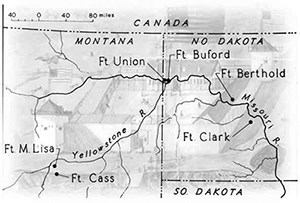Last updated: July 20, 2020
Article
19th Century Archeology at Fort Union Trading Post National Historic Site

History
Fort Union was established by the Upper Missouri Outfit (U.M.O) of the American Fur Company in 1823. Fort Union was the headquarters for the U.M.O for almost 40 years. As the center of an immense American economic empire, Fort Union controlled the trade of furs and bison robes. This control covered Wyoming, Montana, South Dakota, and North Dakota.

During its prime, Fort Union employed up to 200 people. These workers were mostly Métis (an American Indian group of French and Indian ancestry) and French Canadians. Many workers had American Indian wives and lived with their children near the fort. Fort Union was the primary trading post for the Assiniboine tribe.
Many workers’ families lived on the plains around the post. Families with the highest prestige were housed in Fort Union. The most common item traded at the Fort Union was bison robes despite the fort’s focus on beaver pelts. These bison robes were traded for cloth, guns, cooking pots, and other trade goods.
Many workers’ families lived on the plains around the post. Families with the highest prestige were housed in Fort Union. The most common item traded at the Fort Union was bison robes despite the fort’s focus on beaver pelts. These bison robes were traded for cloth, guns, cooking pots, and other trade goods.

Excavation
In December 1985, Congress passed a bill mandating the reconstruction of the trading post at Fort Union National Historic Site. Realizing that an important archeological site would be destroyed, the National Park Service told its Midwest Archeological Center (MWAC) to salvage the site. In 1986, MWAC started to excavate the site. MWAC archeologist Bill Hunt led several teams who excavated 4,400 square meters.

Research Collection
The large volume of artifacts and records generated during fieldwork reflects the scale of the project. This information provides the historical archeologist with many data sets about the history and culture of the American bison robe trade. The archeological data reflect Fort Union’s role as a “company town” whose business occurred as a unique interaction between two cultures. The volume and diversity of artifacts makes it one of the foremost collections of fur trade objects in the world.

Data gathered from the excavations were used to partially reconstruct the post to its 1850-1851 appearance. The reconstructed features include the Bourgeois House, Main Gate, North Gate, stone bastions, and the last of three superimposed Indians’ and Artisans’ Houses. Other excavated structures include the dairy, elements of the 1828 palisade, and a host of secondary features (fences, walkways, a lumber mill, secondary stockade, minor storage buildings, privy pits, and a well).
Tags
- fort union trading post national historic site
- archeology
- archaeology
- north dakota
- midwest region
- plains
- midwest archeological center
- fort union national historic site
- trading post
- native american
- american indian
- assiniboine
- métis
- french canadian
- fur trade
- research
- documentation
- excavation
- terrestrial
- curation
- interpretation
- midwest
- midwestnps
- nebraska
